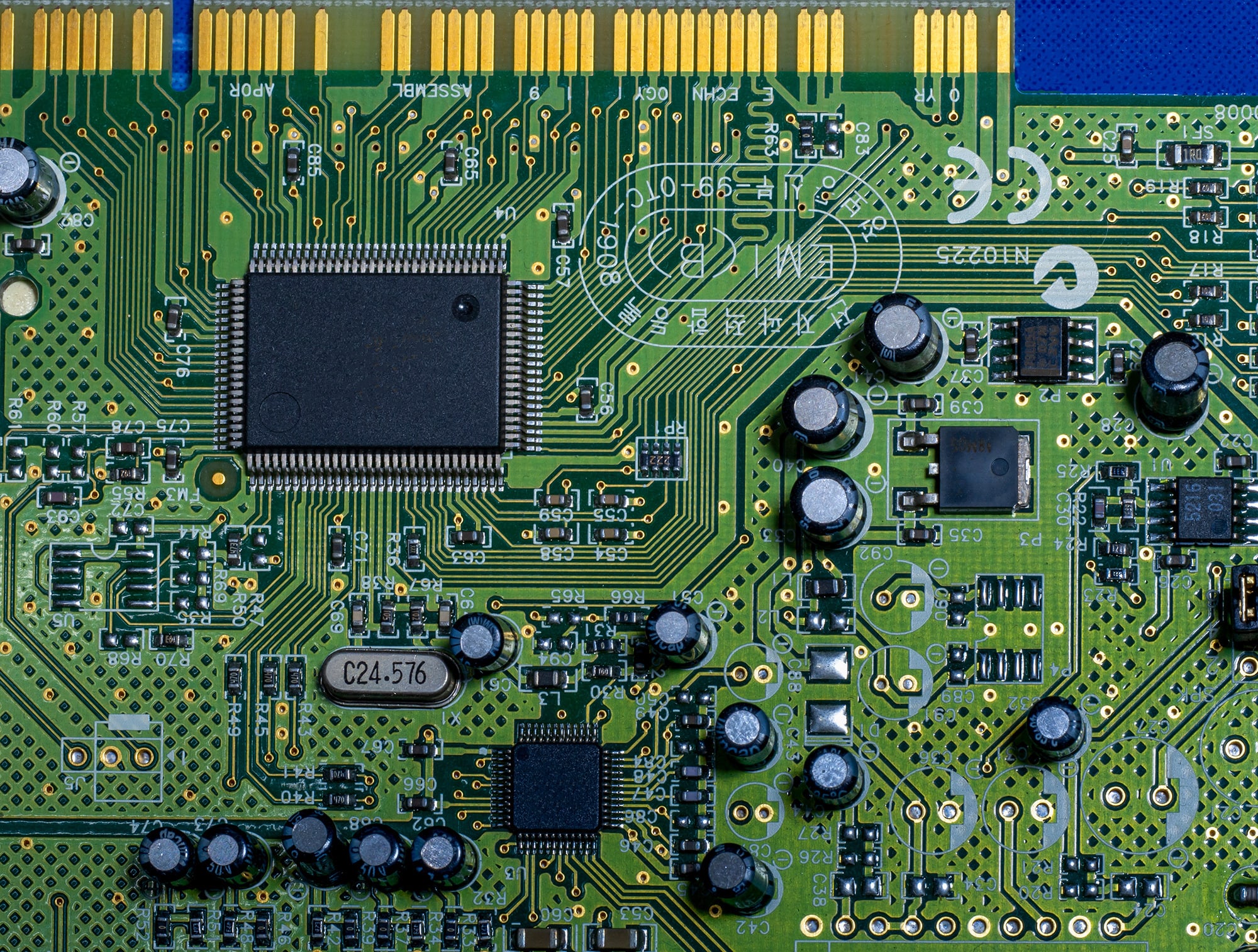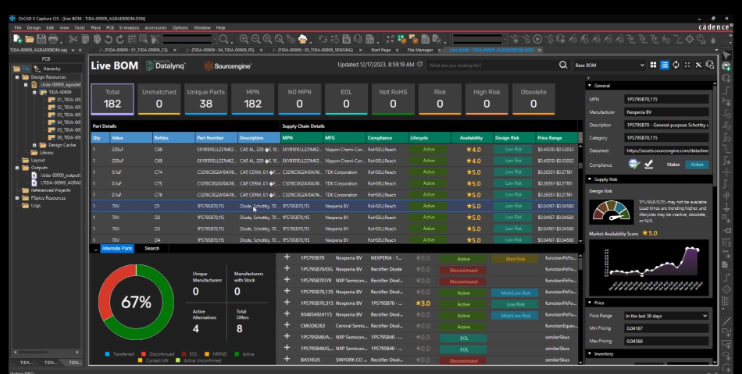PCB Component Selection Guide in OrCAD X
Key Takeaways
-
Define key electrical and physical parameters to ensure component suitability for performance and manufacturability.
-
Use OrCAD X for footprint verification, PSpice simulations, and cross-probing between schematic and layout.
-
Leverage Live BOM in OrCAD X for real-time supply chain insights, cost tracking, and alternative component selection.

PCB component selection is important in balancing a reliable, cost-efficient, and manufacturable design. This article outlines the technical process for selecting components that meet design requirements and performance needs.
PCB Component Selection Quick-Start
Start with a functional block diagram outlining signal flow and subsystem needs. Define key parameters to guide component selection—elements may include voltage, current, frequency, and power consumption. Ensure components exceed maximum operating levels, offer tight tolerance and stable temperature coefficients, and match the required environmental class. Additionally, balance performance with cost, supplier reliability, and physical footprint compatibility using simulation tools like OrCAD X.
PCB Component Selection Criteria
|
Parameter |
Consideration |
Decision Guidelines |
|
Voltage/Current Rating |
Must exceed maximum operating levels to maintain safe margins. |
Design with at least a 20-30% headroom over maximum expected voltage/current. Verify against manufacturer datasheets and safety standards (e.g., UL, IEC) for your application. |
|
Environmental Rating |
Must match the required PCB class (e.g., commercial vs. high-reliability applications). |
Follow IPC standards (e.g., IPC-2221, IPC-7351) for environmental classification. Ensure components are rated for the expected temperature and humidity ranges of your application (Class 2 for commercial or Class 3 for high-reliability systems). |
|
Performance & Tolerance |
Meet electrical and thermal specifications without over-specification; ensure precision and stability. |
For precision applications, use 1% or better tolerance; for less critical circuits, 5% may suffice. Confirm thermal coefficients meet the operating range requirements as defined by relevant standards (e.g., MIL-STD). |
|
Cost & Supply Chain |
Balance unit cost, lead times, supplier reliability, and regulatory compliance to avoid production delays. |
Compare quotes across multiple suppliers; target a balance where cost savings do not compromise quality. Ensure parts are RoHS compliant and have acceptable lead times (within 6-8 weeks for production). |
|
Reliability & Upgradability |
Use reputable manufacturers with long lifecycle support to reduce obsolescence risks. |
Choose parts with documented reliability (e.g., Mean Time Between Failures) and at least 5-10 years of availability. Check manufacturer’s lifecycle information and MSL ratings where applicable. |
|
Physical Footprints |
Ensure footprints and pad dimensions align with PCB layout requirements; verify via design tools. |
Use datasheet-recommended footprints and cross-check with OrCAD-X footprint libraries. Ensure tolerances on pad sizes and clearances conform to IPC design rules (e.g., IPC-2221). |
|
BOM Management |
Group identical parts and provide live updates for replacements, cost, and availability trends. |
Utilize BOM to monitor component lifecycle, cost fluctuations, procurement risk levels and replacement criteria. Live BOM* streamlines procurement and design workflows by providing real-time data |
*Live BOM is a real-time supply chain analysis integrated directly within the schematic in OrCAD X
PCB Component Selection Workflow
-
Define Requirements:
-
Create a functional block diagram outlining key parameters (voltage, current, frequency, power, and environmental conditions).
-
Review Specifications:
-
Evaluate datasheets for electrical performance, tolerance, and thermal ratings to ensure components meet design needs.
-
Check Physical Compatibility:
-
Verify component footprints, pad dimensions, clearances, and connectors to ensure proper fit in the PCB layout and enclosure.
-
Simulate Performance and Cross-Probe Verification:
-
Use OrCAD-X PSpice to simulate circuit behavior and perform Monte Carlo analysis for yield and reliability assessment as needed.
-
Cross-probe between schematic, layout, and BOM to ensure design synchronization and accuracy.
-
Generate and Analyze BOM:
-
Create a BOM using OrCAD-X tools; review live cost, availability, and replacement options via the Live BOM dashboard. Finalize selections based on technical performance, cost efficiency, and supply chain resilience before production
How OrCAD X Aids In PCB Component Selection
OrCAD-X streamlines the PCB component selection process by providing engineers with an intuitive, centralized platform to explore, evaluate, and choose from a vast library that includes three integrated 3rd party component vendors. The search and filtering options make it simple to find parts that meet specific design criteria. Easily make informed decisions with access to the Live BOM dashboard where you have real-time access to information such as availability, cost, and alternate options.
BOM Export and Integration
Use OrCAD X BOM export and supplier integration features to verify that components meet industry standards and are available on schedule. OrCAD X supports the following BOM types:
-
Standard BOM: Groups identical components into single line items for a concise overview.
-
In the top navbar, navigate to the “Tools” dropdown, then select “Bill of Materials.
-
CIS BOM: Lists each reference designator individually—ideal for detailed footprint assignments and Excel exports.
-
In the top navbar, navigate to the “Reports” dropdown and select “CIS Bill of Materials.”

OrCAD X screenshot of BOM file in the top navbar
Live BOM in OrCAD-X
Live BOM in OrCAD-X is a comprehensive electronic BOM management solution that streamlines procurement and design workflows by providing real-time data on component costs, availability, and production status.

Live BOM Dashboard in OrCAD X provides a risk profile of their components.
How OrCAD X Live BOM Aids in PCB Component Selection
|
Feature |
Description |
Advantage in PCB Component Selection |
|
Real-Time Insights |
Tracks cost and availability trends using rolling 30-, 60-, and 90-day intervals. |
Enables proactive purchasing by monitoring price fluctuations. Helps forecast future costs and stock levels for better decision-making. |
|
Replacement & Inventory Risk |
Provides a general risk profile of the BOM based on component availability and the multitude of replacements (equivalents, alternatives, and drop-ins) |
Facilitates quick substitutions when preferred components are unavailable. Mitigates supply chain risks by providing reliable alternative options. |
|
BOM Variant Integration |
Integrates with Workspace and Part Manager to support multiple BOM variants (e.g., prototype vs. mass production) and track revisions. |
Supports iterative design changes by managing different BOM versions. Allows for comparison of different component configurations. Ensures design consistency across product variants with minimal rework. |
|
All-in-One Dashboard |
Consolidates cost trends, production updates, and compliance data (e.g., RoHS) into a single, unified view. |
Provides a comprehensive overview of component status for rapid assessment. Simplifies procurement workflows by centralizing critical supply chain and compliance information. |
PCB component selection is crucial not only for optimal circuit performance but also for managing cost, weight, and supply chain resilience. Discover how Live BOM can transform your design and procurement workflow with Cadence's PCB Design and Analysis Software and OrCAD X platform.
Leading electronics providers rely on Cadence products to optimize power, space, and energy needs for a wide variety of market applications. To learn more about our innovative solutions, talk to our team of experts or subscribe to our YouTube channel.